 |
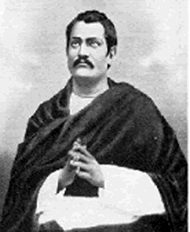 Early Life Early Life
Keshub Chandra Sen was the son of Peary Mohan Sen and the grandson of Dewan Ram Kamal Sen. He was born into a deeply religious Vaishnava family and from his childhood he was surrounded by religious influences.
From an early part of his life he showed an aptitude for influencing other people's minds and at the age of 17, in 1855 he established "The British India Society" where Rev. James Long and Rev. Dall - the Unitarian missionary took part. The society opened an evening school at the house of Sen.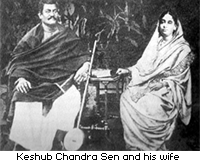 At this age there was an incident during a college examination which left a deep mark on him. He married in 1856 and in his lecture "Am I an Inspired Prophet" he writes "I entered the world with ascetic ideas; and my honeymoon was spent amid auterities in the house of the Lord". At this age there was an incident during a college examination which left a deep mark on him. He married in 1856 and in his lecture "Am I an Inspired Prophet" he writes "I entered the world with ascetic ideas; and my honeymoon was spent amid auterities in the house of the Lord".
Joining Brahmo Samaj
He joined the Brahmo Samaj in 1857 by privately signing the Brahmo covenant and took to studying mental and moral philosophy. He developed prayer as means of spiritual illumination and sustenance. He studied the writings of Theodor Parker and developed a society called "Goodwill Fraternity" in his house and developed lectures on moral and religious subjects. Debendranath Tagore gave Keshub a warm welcome and an attachment sprang up between them the like of which has seldom been seen. Hundreds began to flock into the services of the Samaj to hear them speak and the songs composed by Satyendranath, the second son of Maharshi was the talk of the town. This can be regarded as the second great revival of the Brahmo Samaj.
In 1859 he set up the Brahmo School where weekly lectures were delivered and was greatly popular with the rising generation. In 1860 he began publishing tracts which was the trumpet call of the new Brahmoism and the first chapter was called,"Young Bengal, this is for you".
Sangat Sabha
During this time in 1860, the Sangat Sabha was established - which was a society of fellow believers to promote mutual spiritual intercourse amongst its members. This sabha sowed the seeds of new Brahmoism. Keshub broke away from the mere intellectual assent and imbibed a new inspiration from the Western sources. A careful study of the Bible, works of Theodor Parker and Prof. Newman brought about the Christian spirit of repentance and prayer.
Brahmananda
On 13th April, 1862, Debendranath elevated Keshub Chandra Sen to the post of Minister or Acharya of the Samaj. After the divine service he presented him with a Brahmo Dharma and a formal appointment letter and conferred upon him the title of Brahmananda - meaning one whose delight is God. However this was not looked upon well by the older members of the Samaj and some of them ceased to attend the services. On 26th July 1861, the eldest daughter of Debendranath, Sukumari was married according to the reformed rites of the Brahmo Samaj. Debendranath followed the ritual of the orthodox Hindu marriages but excluded the idolatrous bits. This was hailed as a great step towards social reform.
The Schism
The flames of the conflict between the young and the old were heightened further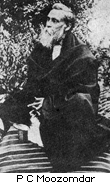 with the young protesting against the custom of allowing sacred thread - bearing Brahmins to occupy its pulpits. This led to Debendranath removing them from all office and power of the Samaj. To counter the Tattwabodhini Patrika, the young started the Dharmatattwa. He started the 'Indian Mirror' as a fortnightly in 1861 and made it into a daily in 1871. In 1862 Keshub undertook the ministry of one of its branches. In the same year he helped to found the Albert College and started the Indian Mirror, a weekly journal in which social and moral subjects were discussed. In 1863 he wrote The Brahma Samaj Vindicated. He also travelled about the country lecturing and preaching. In 1865 Keshub delivered a lecture on Struggle for Religious Independence where he condemned the high - handed feelings of the Calcutta (Adi) Brahmo Samaj and a representation was sent to Debendranath signed by Keshub, P C Mozoomdar and others. On 11th November 1866 a meeting was held in the house of the Calcutta College and the Brahmo Samaj of India was formally established. At this time there were 54 Samajes in India, 50 in Bengal, 2 in North Western Province, one in Punjab and the other in Madras. After the schism, the Adi Brahmo Samaj quietly retreated to its position of Hindu monotheism - and Debendranath remained silent and never replied to any of the accusations. He also retired from active work of the Samaj and spent most of his time travelling and occasionally visiting Calcutta. with the young protesting against the custom of allowing sacred thread - bearing Brahmins to occupy its pulpits. This led to Debendranath removing them from all office and power of the Samaj. To counter the Tattwabodhini Patrika, the young started the Dharmatattwa. He started the 'Indian Mirror' as a fortnightly in 1861 and made it into a daily in 1871. In 1862 Keshub undertook the ministry of one of its branches. In the same year he helped to found the Albert College and started the Indian Mirror, a weekly journal in which social and moral subjects were discussed. In 1863 he wrote The Brahma Samaj Vindicated. He also travelled about the country lecturing and preaching. In 1865 Keshub delivered a lecture on Struggle for Religious Independence where he condemned the high - handed feelings of the Calcutta (Adi) Brahmo Samaj and a representation was sent to Debendranath signed by Keshub, P C Mozoomdar and others. On 11th November 1866 a meeting was held in the house of the Calcutta College and the Brahmo Samaj of India was formally established. At this time there were 54 Samajes in India, 50 in Bengal, 2 in North Western Province, one in Punjab and the other in Madras. After the schism, the Adi Brahmo Samaj quietly retreated to its position of Hindu monotheism - and Debendranath remained silent and never replied to any of the accusations. He also retired from active work of the Samaj and spent most of his time travelling and occasionally visiting Calcutta.
The tenets of the Brahmo Samaj of India at ths time were the following: (1) The wide universe is the temple of God. (2) Wisdom is the pure land of pilgrimage. (3) Truth is the everlasting scripture. (4) Faith is the root of all religions. (5) Love is the true spiritual culture. (6) The destruction of selfishness is the true asceticism. In 1866 he delivered an address on - Jesus Christ, Europe and Asia, which led to the false impression that he was about to embrace Christianity.
New Dispensation
On 24th January 1868, Keshub laid the foundation stone of his new church, the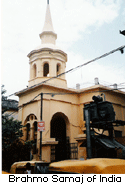 Tabernacle of New Dispensation and the newly constructed chapel was consecrated on 22nd August 1869. Tabernacle of New Dispensation and the newly constructed chapel was consecrated on 22nd August 1869. 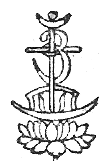 He declared, "we believe in the Church Universal, which is the respiratory of all ancient wisdom and the receptacle of all modern science, which recognise in all prophets and saints a harmony, in all scriptures a unity and though all dispensations a continuity, which abjures all that separates and divides and always magnifies unity and peace, which harmonises reason, faith and Bhakti, asceticism and social duty in their highest forms and which shall make of all nations and sects one kingdom and one family in the fullness of time." In the anniversary festival of 1879, Keshub announced the birth of the New Dispensation. He introduced into the church the Pilgrimage to saints, the Homa ceremony, the Baptismal ceremony, the Lord's supper, the Flag ceremony, the Arati, the vow of Poverty, the Savitri Vrata, the Nightingale Vrata, and other innovations. He mentions that this New Dispensation is "...a Divine message sent to India... It comes not to destroy but to fulfil the law and the prophets." His most important contribution is the habit of daily devotion. He felt the necessity of daily domestic devotion and laid down the essential condition of domestic life in his Nava Samhita In 1869, universalism was further strengthened by publishing of four books - Gour Govinda Roys' work on the Gita, P C Mozoomdar's book The Oriental Christ, Aghor Nath Gupta's study on Buddha and Girish Chandra Sen's Tapasmala - life of Muslim saints and his Bengali translation of Koran and Hadis. There was also a Pilgrimage to the Saints - special service held in the memory of great men like Moses, Socrates, Sakya, The Rishis, Christ, Muhammad, Chaitanya, Scientific men. He declared, "we believe in the Church Universal, which is the respiratory of all ancient wisdom and the receptacle of all modern science, which recognise in all prophets and saints a harmony, in all scriptures a unity and though all dispensations a continuity, which abjures all that separates and divides and always magnifies unity and peace, which harmonises reason, faith and Bhakti, asceticism and social duty in their highest forms and which shall make of all nations and sects one kingdom and one family in the fullness of time." In the anniversary festival of 1879, Keshub announced the birth of the New Dispensation. He introduced into the church the Pilgrimage to saints, the Homa ceremony, the Baptismal ceremony, the Lord's supper, the Flag ceremony, the Arati, the vow of Poverty, the Savitri Vrata, the Nightingale Vrata, and other innovations. He mentions that this New Dispensation is "...a Divine message sent to India... It comes not to destroy but to fulfil the law and the prophets." His most important contribution is the habit of daily devotion. He felt the necessity of daily domestic devotion and laid down the essential condition of domestic life in his Nava Samhita In 1869, universalism was further strengthened by publishing of four books - Gour Govinda Roys' work on the Gita, P C Mozoomdar's book The Oriental Christ, Aghor Nath Gupta's study on Buddha and Girish Chandra Sen's Tapasmala - life of Muslim saints and his Bengali translation of Koran and Hadis. There was also a Pilgrimage to the Saints - special service held in the memory of great men like Moses, Socrates, Sakya, The Rishis, Christ, Muhammad, Chaitanya, Scientific men.
Visit to England
1870 he paid a visit to England. The Hindu preacher was warmly welcomed by almost all denominations, particularly by the Unitarians, with whose creed the new Brahma Samaj had most in common, and it was the committee of the British and Foreign Unitarian Association that organised the welcome soire at Hanover Square Rooms on the 12th of April. Ministers of ten different denominations were on the platform, and among those who officially bade him welcome were Lord Lawrence and Dean Stanley. He remained for six months in England, visiting most of the chief towns. His eloquence, delivery and command of the language won universal admiration. His own impression of England was somewhat disappointing. Christianity in England appeared to him too sectarian and narrow, too muscular and hard, and Christian life in England more materialistic and outward than spiritual and inward. He said, "I came here an Indian, I go back a confirmed Indian; I came here a Theist, I go back a confirmed Theist. I have learnt to love my own country more and more". These words spoken at the farewell soire may furnish the key to the change in him which so greatly puzzled many of his English friends.
Cooch Behar Marriage and the schism
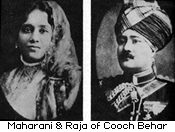 In 1877 there was a strong rumour that Keshub was giving his eldest daughter, Suniti, in marriage to the young Maharaja of Cooch Behar. The main reason for the controversy was Suniti was not yet 14, the minimum age according to Marriage Act, 1872 and the Raja a lad of fifteen. By 1878 the information received by the Brahmos was 1) The marriage was to take place immediately prior to departure of the prince to England, 2)It will be celebrated according to the Cooch Behar rituals with idolatrous portions expunged 3)Keshub's brother Krishna Behari Sen was to give away the bride as Keshub having lost caste would be excluded from the function and 4) Cooch Behar priests will be officiating the service and no Brahmo service or Brahmo ministers will have anything to do with the ceremony. 23 Brahmos signed a letter of protest but Keshub did not even read the letter far less reply to it. As per the official records of Cooch Behar, "The rites observed were Hindu in all esential features though in deference to the religious principles of the bride's father, idolatrous mantras were ommitted and the presence of an idol was dispensed with. Care was, however taken to retain whatever the Brahmins considered essential to the validity of the marriage". The constitutionalists had organised themselves in to a party called Samadarshi or Liberal in 1874 and started a paper called Samadarshi to voice their opinion. A lot of Brahmos and provincial Samajes voiced their concerns and as a result of the meeting held in the Town Hall on 15th May 1878, the Sadharan Brahmo Samaj was born. In 1877 there was a strong rumour that Keshub was giving his eldest daughter, Suniti, in marriage to the young Maharaja of Cooch Behar. The main reason for the controversy was Suniti was not yet 14, the minimum age according to Marriage Act, 1872 and the Raja a lad of fifteen. By 1878 the information received by the Brahmos was 1) The marriage was to take place immediately prior to departure of the prince to England, 2)It will be celebrated according to the Cooch Behar rituals with idolatrous portions expunged 3)Keshub's brother Krishna Behari Sen was to give away the bride as Keshub having lost caste would be excluded from the function and 4) Cooch Behar priests will be officiating the service and no Brahmo service or Brahmo ministers will have anything to do with the ceremony. 23 Brahmos signed a letter of protest but Keshub did not even read the letter far less reply to it. As per the official records of Cooch Behar, "The rites observed were Hindu in all esential features though in deference to the religious principles of the bride's father, idolatrous mantras were ommitted and the presence of an idol was dispensed with. Care was, however taken to retain whatever the Brahmins considered essential to the validity of the marriage". The constitutionalists had organised themselves in to a party called Samadarshi or Liberal in 1874 and started a paper called Samadarshi to voice their opinion. A lot of Brahmos and provincial Samajes voiced their concerns and as a result of the meeting held in the Town Hall on 15th May 1878, the Sadharan Brahmo Samaj was born.
David Kopf mentions in his book, "The indictment of Keshub for having married off his eldest daughter in violation of every Brahmo precept has generally been accepted in historical surveys, which treat the marriage as a disaster from every point of view and ignore the aftermath of the event." A fact that is often overlooked is that the marriage was not consummated until 1880 when Prince Nripendra Narayan and Suniti Devi were 18 and 16 respectively. It was an experiment under the guidance of the British officials (who arranged the marriage in the first place) opening the remote kingdom to the enlightening influences from Calcutta. Kopf writes "...Thus whether the marriage was not performed strictly according to Brahmo rites seems insignificant from a historical perspective than the question about the subsequent career of the Maharaja,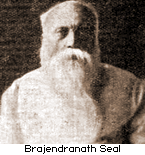 whom Keshub sought to inspire as a Brahmo. The answer in large part can be found in the qualitative difference between the town of Cooch Behar before the accession of Nripendra Narayan to the throne in 1882, and the town Brajendranath Seal came to live in 1896 when he was hired at Victoria College. In those fourteen years alone, through increasing the annual revenue of state by 300,000 rupees, the king regularised the administration, established the first railway link to Bengal, improved communication throughout the kingdom with the construction of innumerable roads and bridges, created for the first time a city with a planned sanitation and drainage system, constructed the earliest buildings in the country dedicated to the principles of modern justice and administration, started a 1arge fully equipped hospital in the capital and public dispensaries in the countryside, and founded Cooch Behar's first public library, public parks and gardens, a girls' school, college, and a public marketplace. He also abolished polygamy in the royal family and capital punishment throughout the kingdom". whom Keshub sought to inspire as a Brahmo. The answer in large part can be found in the qualitative difference between the town of Cooch Behar before the accession of Nripendra Narayan to the throne in 1882, and the town Brajendranath Seal came to live in 1896 when he was hired at Victoria College. In those fourteen years alone, through increasing the annual revenue of state by 300,000 rupees, the king regularised the administration, established the first railway link to Bengal, improved communication throughout the kingdom with the construction of innumerable roads and bridges, created for the first time a city with a planned sanitation and drainage system, constructed the earliest buildings in the country dedicated to the principles of modern justice and administration, started a 1arge fully equipped hospital in the capital and public dispensaries in the countryside, and founded Cooch Behar's first public library, public parks and gardens, a girls' school, college, and a public marketplace. He also abolished polygamy in the royal family and capital punishment throughout the kingdom".
"Moreover, some years before Brajendranath's arrival in Cooch Behar, the king and his wife constructed the largest Brahmo Mandir in South Asia, primarily with government funds, and they provided an annual grant of 5,000 rupees to help maintain it. In 1888, the king declared Brahmoism of the New Dispensation as the state religion, and though it had no practical effect in spreading the faith beyond the small community of Bengali elite, it did suggest that the promise of the young man to Keshub was fulfilled. Not well known, either, is that Maharaja Nripendra Narayan, whom the critics of Keshub had looked upon as a jungly Hindu raja, left three wishes behind him shortly before his death at forty-nine years of age. The king asked first that he be cremated according to the New Dispensation Brahmo rites; second, that his ashes be put in the same garden in Cooch Behar where he had first learned to read and write; and third, he provided that "his casket be placed in a monument of stone similar to the one which had been placed over the ashes of the late Keshub Chandra Sen."
Relation with Ramakrishna Paramhansa
 After the Cooch Behar marriage Keshub took an important line of departure by entering upon a system of spiritual interpretation o fthe idol deity and her attendants. He also started visting the mystic saint Ramakrishna and it was Keshub and his party who were instrumental in bringing him to public notice. Ramakrishna was present in many Brahmo gatherings. David Kopf gives three reasons for this attraction which deserve attention. First, Ramakrishna was not susceptible to formal education, English or indigenous; this separated him from other Brahmos of whatever ideological bent. Secondly, Ramakrishna's Tantric way of sublimating the sensual drive for women into a spiritual drive for the Divine Mother appealed to Keshub Chandra. Third, Ramakrishna claimed to have experienced direct, intuitive contact with all major religious leaders in history. "In this sense, the Hindu Ramakrishna was perhaps more universalist and Brahmo than most of the Brahmo ascetics, who were narrowly Vaishnava." These three aspects of Ramakrishna's career as a mystic were probably strong influences on Keshub from March 1875 onwards, when the two men presumably first met at the Kali temple at Dakshineshwar. Keshub was intrigued by the religious experiments performed by Ramakrishna, and wished to adapt them to his own use, especially those elements of the Sakto tradition in Bengal that emphasised the motherhood of God. The idea of differentiating the good and bad features within Saktism, and incorporating the good into Brahmoism, probably came to Keshub after his acquaintance with Ramakrishna. For, in the early 1860s, Ramakrishna had already performed experiments to purify Saktism and Tantrism. After the Cooch Behar marriage Keshub took an important line of departure by entering upon a system of spiritual interpretation o fthe idol deity and her attendants. He also started visting the mystic saint Ramakrishna and it was Keshub and his party who were instrumental in bringing him to public notice. Ramakrishna was present in many Brahmo gatherings. David Kopf gives three reasons for this attraction which deserve attention. First, Ramakrishna was not susceptible to formal education, English or indigenous; this separated him from other Brahmos of whatever ideological bent. Secondly, Ramakrishna's Tantric way of sublimating the sensual drive for women into a spiritual drive for the Divine Mother appealed to Keshub Chandra. Third, Ramakrishna claimed to have experienced direct, intuitive contact with all major religious leaders in history. "In this sense, the Hindu Ramakrishna was perhaps more universalist and Brahmo than most of the Brahmo ascetics, who were narrowly Vaishnava." These three aspects of Ramakrishna's career as a mystic were probably strong influences on Keshub from March 1875 onwards, when the two men presumably first met at the Kali temple at Dakshineshwar. Keshub was intrigued by the religious experiments performed by Ramakrishna, and wished to adapt them to his own use, especially those elements of the Sakto tradition in Bengal that emphasised the motherhood of God. The idea of differentiating the good and bad features within Saktism, and incorporating the good into Brahmoism, probably came to Keshub after his acquaintance with Ramakrishna. For, in the early 1860s, Ramakrishna had already performed experiments to purify Saktism and Tantrism.
Contribution to Brahmoism
There were many important contribution to the Brahmo movement by Keshub Chandra Sen. These can be briefly stated as follows. The first noteworthy contribution is the enunciation and accentuation of the doctrine of God in conscience. The second great 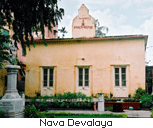 contribution was bringing of man's social life within the domain of his religious duty. The third was imbibing into the spiritual life of the Brahmo Samaj - the spirit of repentance and prayer. Next was his infusion of the bhakti or devitional fervour into the movement. Another was his sense of universalism of theism - he found that all the religious teachers were bound together by a common bond. Next was his faith in the Divine mission of the Brahmo Samaj. Another important contribution was the emphasis of the principle laid down by Rammohun Roy - service of man was the service of God. contribution was bringing of man's social life within the domain of his religious duty. The third was imbibing into the spiritual life of the Brahmo Samaj - the spirit of repentance and prayer. Next was his infusion of the bhakti or devitional fervour into the movement. Another was his sense of universalism of theism - he found that all the religious teachers were bound together by a common bond. Next was his faith in the Divine mission of the Brahmo Samaj. Another important contribution was the emphasis of the principle laid down by Rammohun Roy - service of man was the service of God.
In 1883 soon after his arrival from Simla, with failing health, Keshub caused the foundation of his Nava Devalaya (his domestic chapel). The work was completed on 1st January 1884 and he was carried on the shoulders from his death bed to take part in the consecration ceremony.
|
| |
|